Franco.gh
New Member
The Green House Seed Company has started a real breeding revolution by providing customers and anyone interested with terpens profiles of the resin of all its strains. The 2008-2009 seed catalogue contains an example of this analysys, and the Green House website has the updated profiles for all strains. It is truly an innovative step away from the effect-only approach to cannabis and into the world of smell and flavor, the conoisseur way, a la carte.
Cannabis is seen by many as a medicine or a recreational drug, but the more subtle aspect of it being an aromatic plant goes too often unnoticed. The herbs we use in our kitchen are considered aromatic plants because they contain a particular terpene profile that gives a distinctive flavor. Cannabis is so complex from this point of view that the possible combinations are endless, creating a broad spectrum of aromas and flavors that differ with the strains and the way they are cultivated. We are opening a new way of breeding, a new frontier for all growers with a sweet tooth.
To give you an idea of what a terpene is, a quick look at Wikipedia reveals what follows:
The word terpenes defines a large and varied class of hydrocarbons, produced primarily by plants (conifers and cannabis) and more rarely by insects. Terpens are the major components of resin, and of oils and extracts produced from resin. The name "terpene" is derived from the word "turpentine". Terpenes function as smell and taste molecules, and also as biosynthetic building blocks for the organism of almost all creatures. Terpenes are one of the most important components of the resin and essential oils of many types of plants and flowers.
Enough with the science. Let’s see how these terpens are affecting cannabis in the process of breeding on flavor.
The list of 16 terpens analyzed by Green House Seed Company is a selection of the most carachteristic and recognizable ones, the ones involved in the distinctive flavor of any strain of cannabis. A few example:
Alpha-Pinene is an organic compound, found in the oils of many species of many species of pine trees. It is also found in the essential oil of rosemary (Rosmarinus officinalis). 2 types of Alpha-pinene exist in nature, one more common in European pines, the other more common in North America. A mix of the two is present in the oil extracted from the eucalyptus tree. In the Green House range this terpene is at the highest level in the Super Silver Haze. So if you like pine-tree smelling and tasting weed, think of growing this strain, or use it for crossings.
Limonene is a hydrocarbon, classified as a cyclic terpene. It is a colourless liquid at room temperatures with an extremely strong smell of oranges. It takes its name from the lemon because lemon and other citrus fruits contain high quantities of this compound, which is responsible for much of their smell. In the Green house Strains is particularly high in the Lemon Skunk and the Big Bang.
Sabinene is a natural monoterpene and it is isolated from the essential oils of a variety of plants, mostly oak trees. Sabinene is one of the chemical compounds that contributes to the spiciness of black pepper and is a major constituent of carrot seed oil. It also occurs in tea tree oil at a low concentration. Again, this terpene is high in the Super Silver Haze and in the Arjan’s Ultra Haze #1.
Myrcene, or β-myrcene, is also an organic compound. It is classified as a hydrocarbon and a monoterpene. It is obtained from the essential oil from various plants: bay, verbena, myrcia (from which is gets its name) and others. Myrcene is one of the most important chemicals used in the perfumery industry. Because of its pleasant odor, it is occasionally used directly. But it is also highly valued as an intermediate for the preparation of flavor and fragrance chemicals such as menthol, citronella, and geraniol. It is extremely high in the White Widow.
Many more terpenes are present in the resin and analyzed, and this represent a guide, a useful tool for a more mature type of smoker, conscious about flavor, and for all breeders interested in following a particular aroma in their lines.
Here you will find the graphs and the key to read them. If you wish to print them for your reference, feel free to download the pdf version from the Green House seed Co. website (just click on any of the graphs and the pdf will open in a separate window, ready for download).
key to read graphs

White Widow
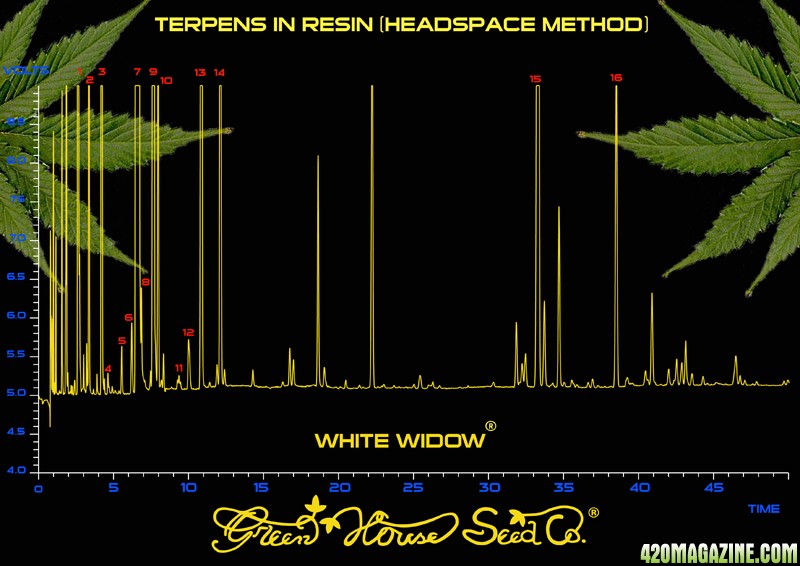
White Rhino
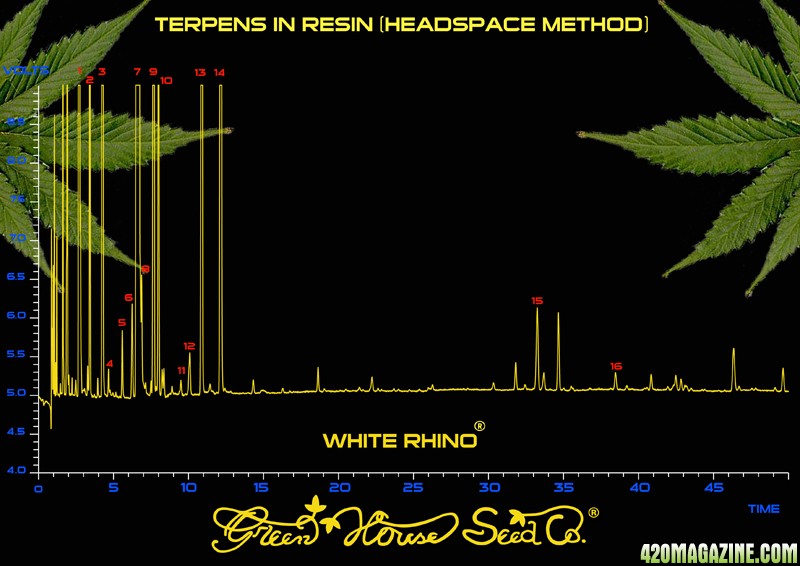
Trainwreck
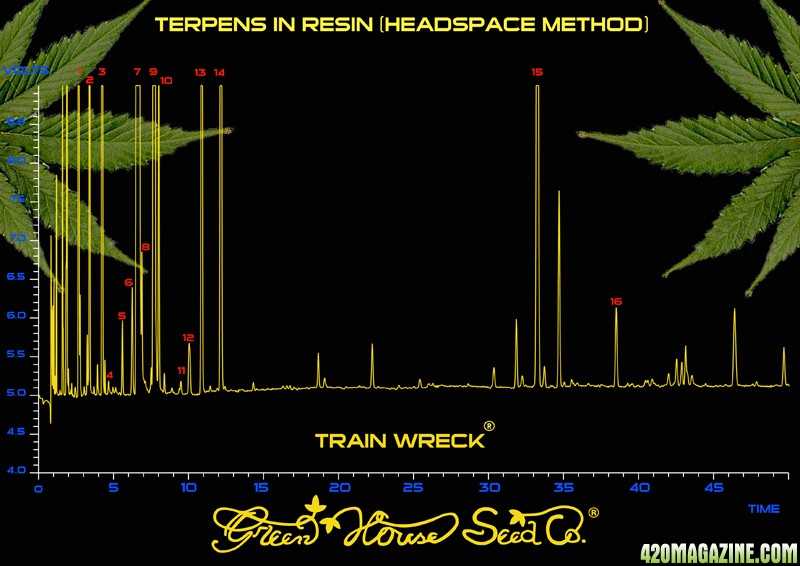
Super Silver Haze
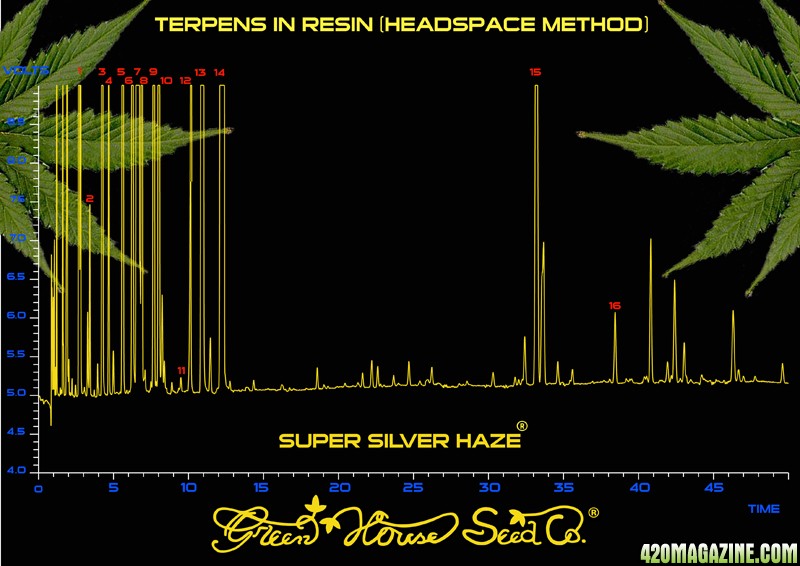
NL5-Haze-Mist
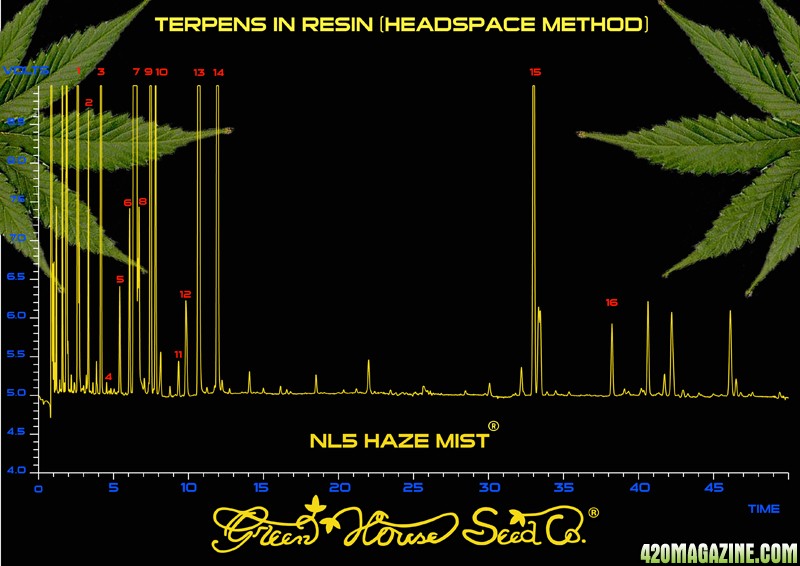
Neville's Haze
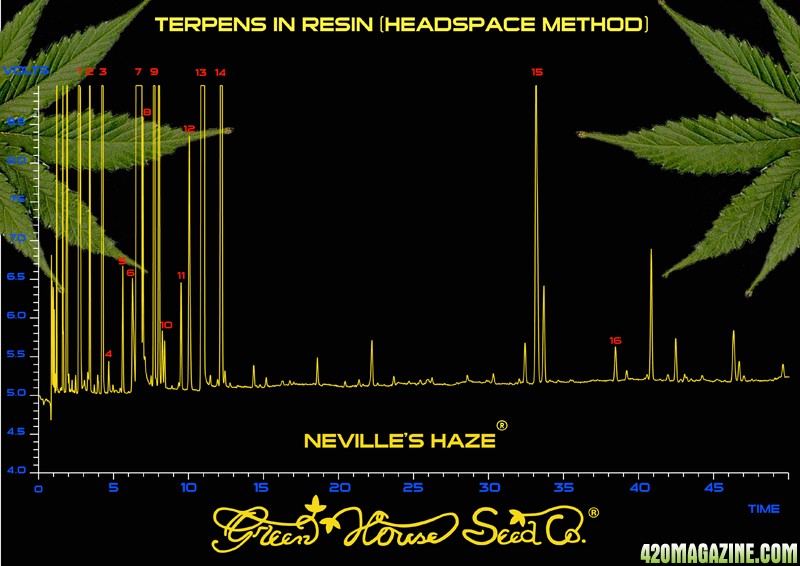
Hawaiian Snow
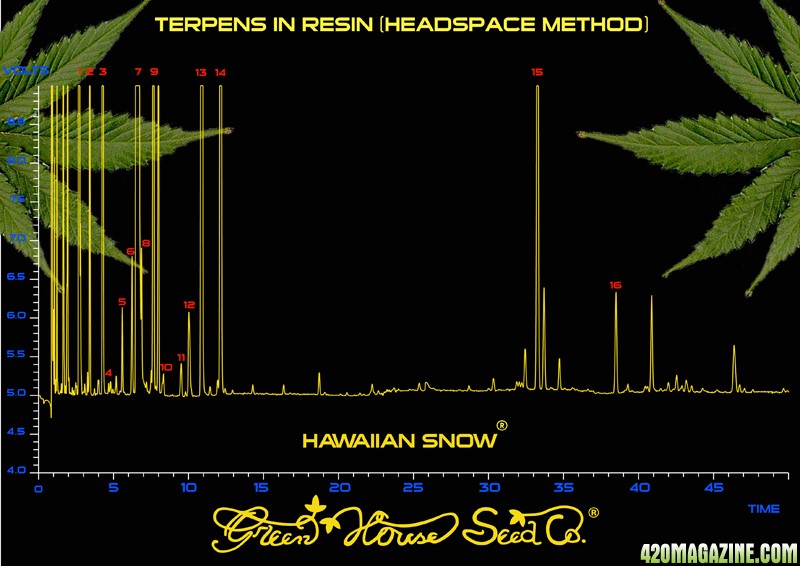
Himalaya Gold
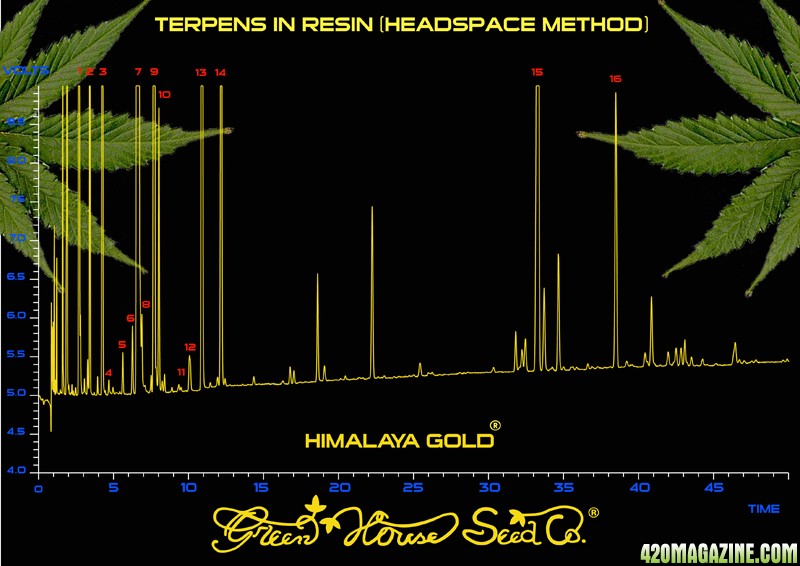
El Nino

The Doctor
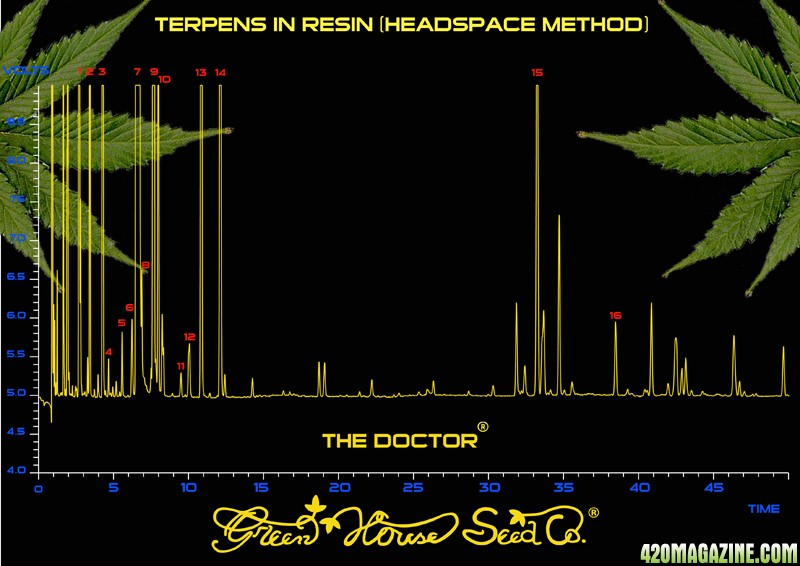
The Church
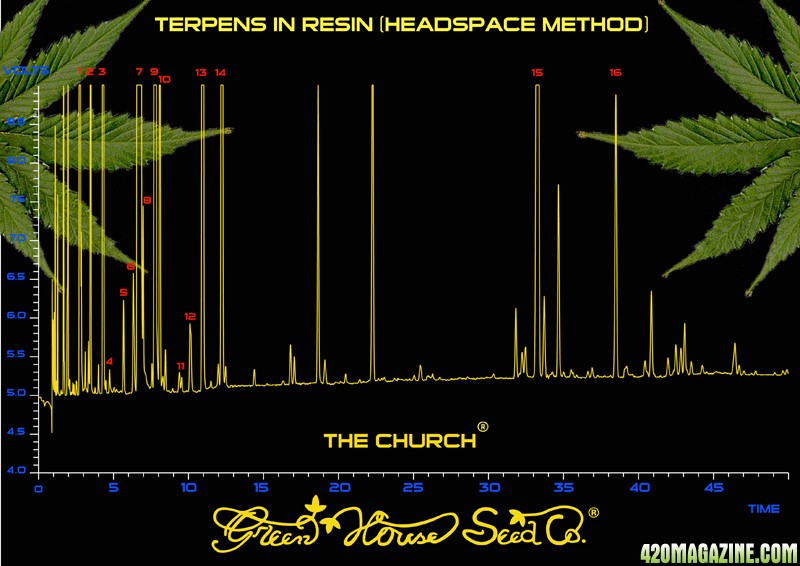
Green House Cheese
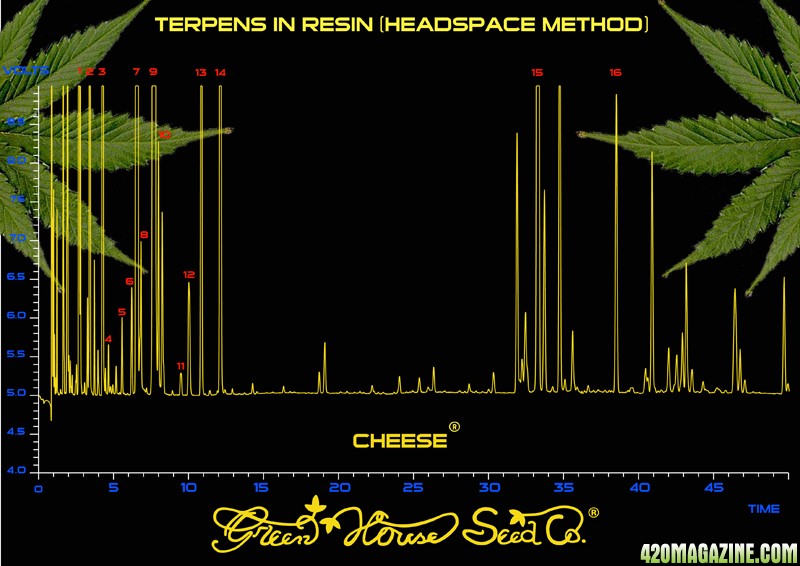
Big Bang
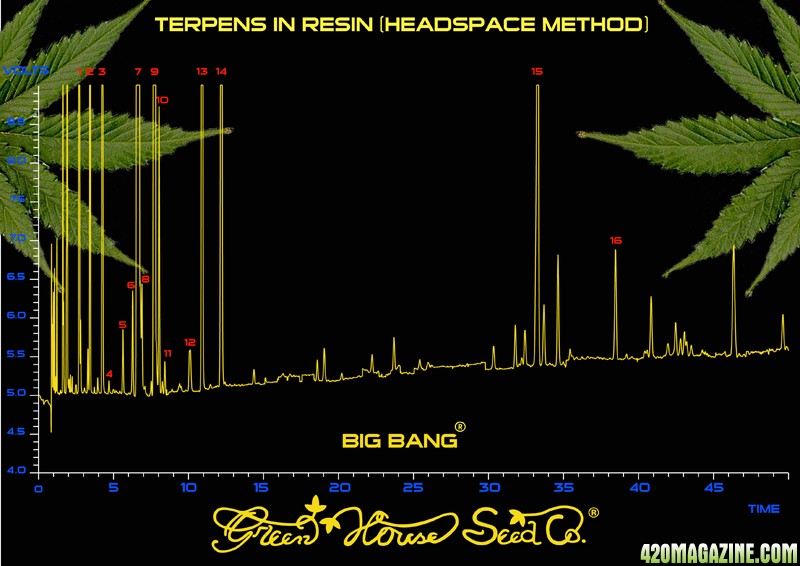
Arjan's Ultra Haze #2
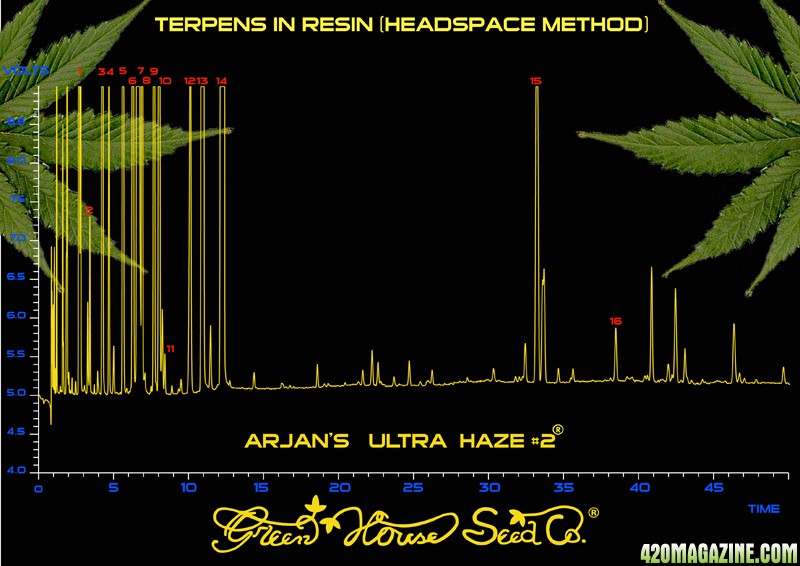
Arjan's Ultra Haze #1
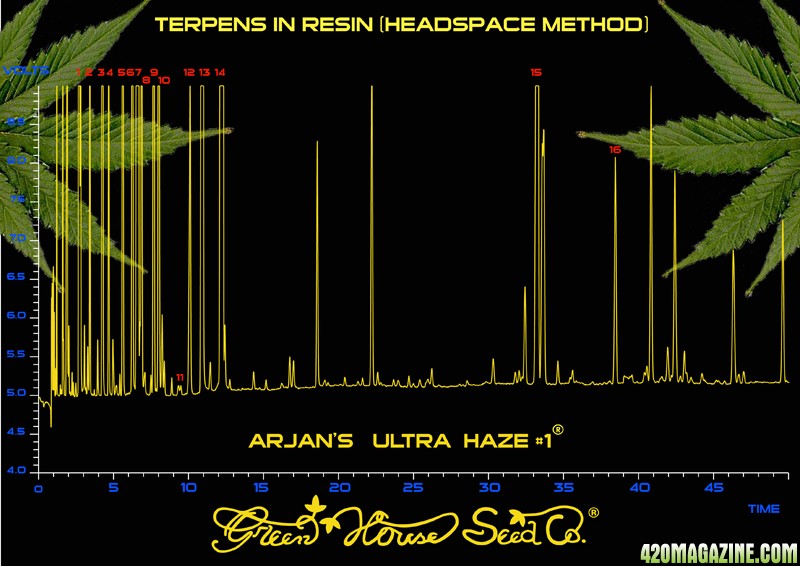
Arjan's Strawberry Haze
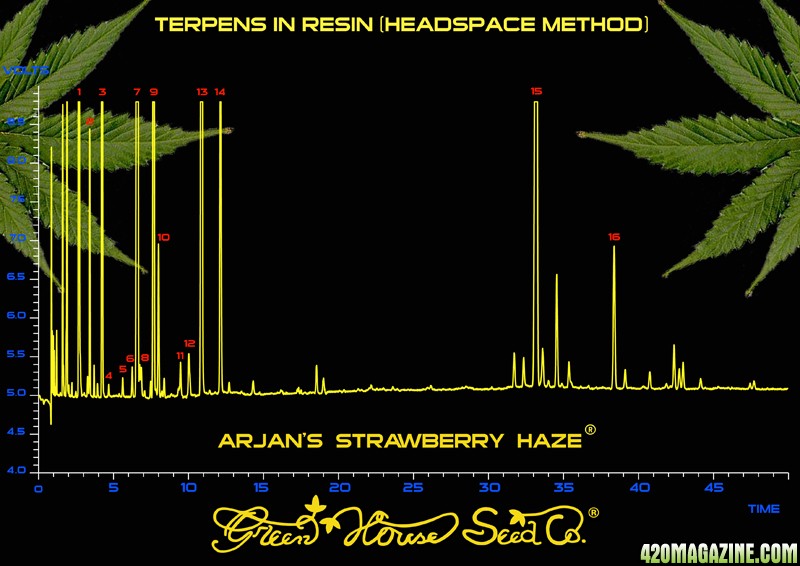
AMS
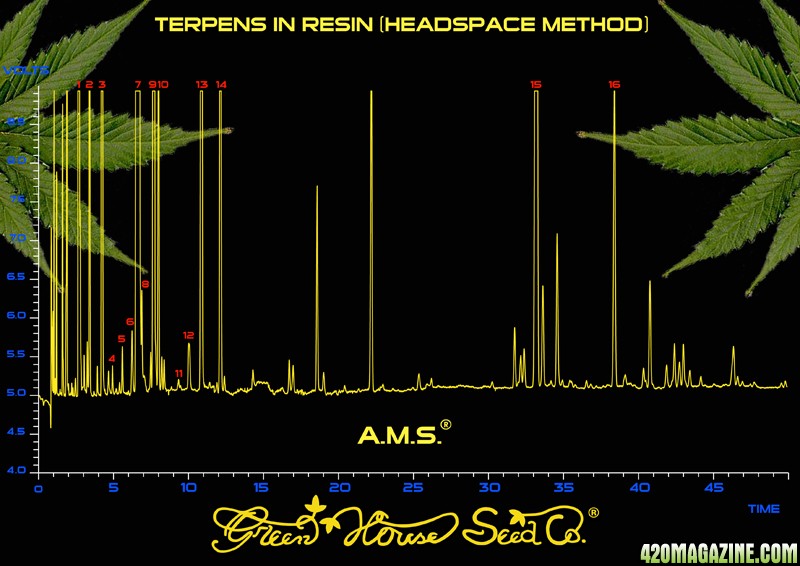
Alaskan Ice
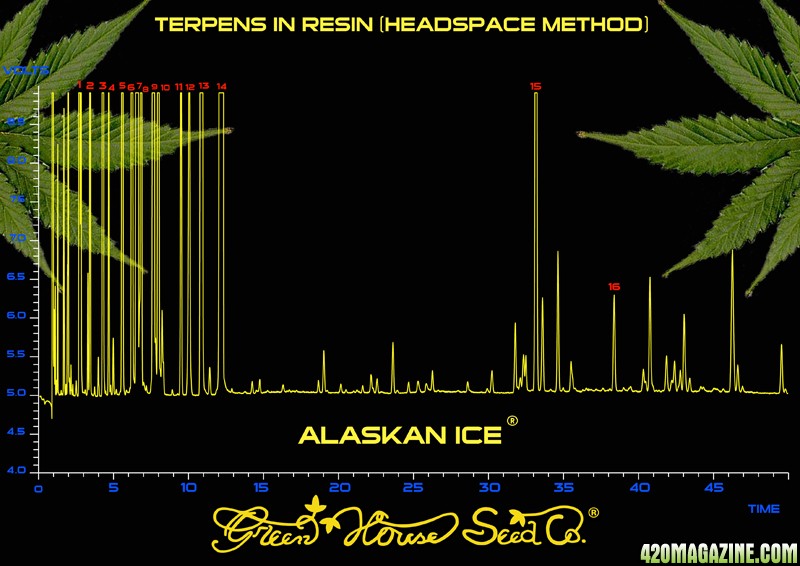
Arjan's Haze #3

Arjan's Haze #2

Arjan's Haze #1
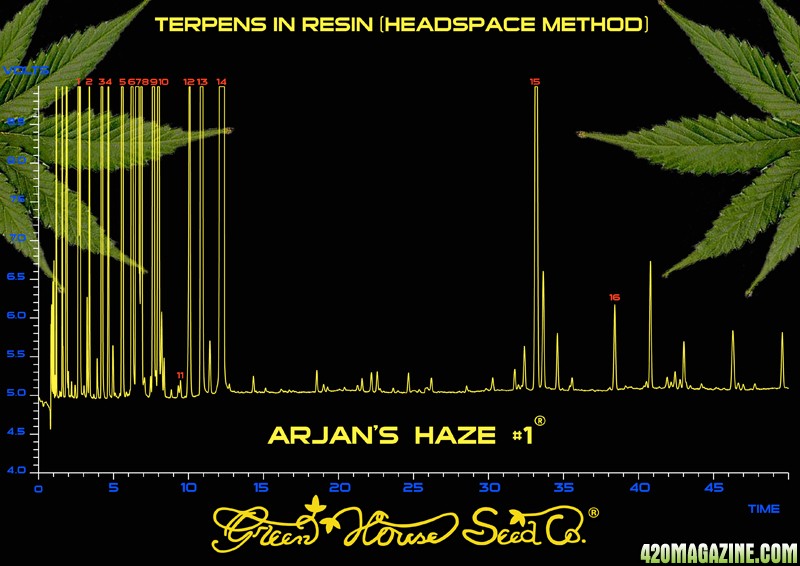

Cannabis is seen by many as a medicine or a recreational drug, but the more subtle aspect of it being an aromatic plant goes too often unnoticed. The herbs we use in our kitchen are considered aromatic plants because they contain a particular terpene profile that gives a distinctive flavor. Cannabis is so complex from this point of view that the possible combinations are endless, creating a broad spectrum of aromas and flavors that differ with the strains and the way they are cultivated. We are opening a new way of breeding, a new frontier for all growers with a sweet tooth.
To give you an idea of what a terpene is, a quick look at Wikipedia reveals what follows:
The word terpenes defines a large and varied class of hydrocarbons, produced primarily by plants (conifers and cannabis) and more rarely by insects. Terpens are the major components of resin, and of oils and extracts produced from resin. The name "terpene" is derived from the word "turpentine". Terpenes function as smell and taste molecules, and also as biosynthetic building blocks for the organism of almost all creatures. Terpenes are one of the most important components of the resin and essential oils of many types of plants and flowers.
Enough with the science. Let’s see how these terpens are affecting cannabis in the process of breeding on flavor.
The list of 16 terpens analyzed by Green House Seed Company is a selection of the most carachteristic and recognizable ones, the ones involved in the distinctive flavor of any strain of cannabis. A few example:
Alpha-Pinene is an organic compound, found in the oils of many species of many species of pine trees. It is also found in the essential oil of rosemary (Rosmarinus officinalis). 2 types of Alpha-pinene exist in nature, one more common in European pines, the other more common in North America. A mix of the two is present in the oil extracted from the eucalyptus tree. In the Green House range this terpene is at the highest level in the Super Silver Haze. So if you like pine-tree smelling and tasting weed, think of growing this strain, or use it for crossings.
Limonene is a hydrocarbon, classified as a cyclic terpene. It is a colourless liquid at room temperatures with an extremely strong smell of oranges. It takes its name from the lemon because lemon and other citrus fruits contain high quantities of this compound, which is responsible for much of their smell. In the Green house Strains is particularly high in the Lemon Skunk and the Big Bang.
Sabinene is a natural monoterpene and it is isolated from the essential oils of a variety of plants, mostly oak trees. Sabinene is one of the chemical compounds that contributes to the spiciness of black pepper and is a major constituent of carrot seed oil. It also occurs in tea tree oil at a low concentration. Again, this terpene is high in the Super Silver Haze and in the Arjan’s Ultra Haze #1.
Myrcene, or β-myrcene, is also an organic compound. It is classified as a hydrocarbon and a monoterpene. It is obtained from the essential oil from various plants: bay, verbena, myrcia (from which is gets its name) and others. Myrcene is one of the most important chemicals used in the perfumery industry. Because of its pleasant odor, it is occasionally used directly. But it is also highly valued as an intermediate for the preparation of flavor and fragrance chemicals such as menthol, citronella, and geraniol. It is extremely high in the White Widow.
Many more terpenes are present in the resin and analyzed, and this represent a guide, a useful tool for a more mature type of smoker, conscious about flavor, and for all breeders interested in following a particular aroma in their lines.
Here you will find the graphs and the key to read them. If you wish to print them for your reference, feel free to download the pdf version from the Green House seed Co. website (just click on any of the graphs and the pdf will open in a separate window, ready for download).
key to read graphs

White Widow

White Rhino

Trainwreck

Super Silver Haze

NL5-Haze-Mist

Neville's Haze

Hawaiian Snow

Himalaya Gold

El Nino

The Doctor

The Church

Green House Cheese

Big Bang

Arjan's Ultra Haze #2

Arjan's Ultra Haze #1

Arjan's Strawberry Haze

AMS

Alaskan Ice

Arjan's Haze #3

Arjan's Haze #2

Arjan's Haze #1




